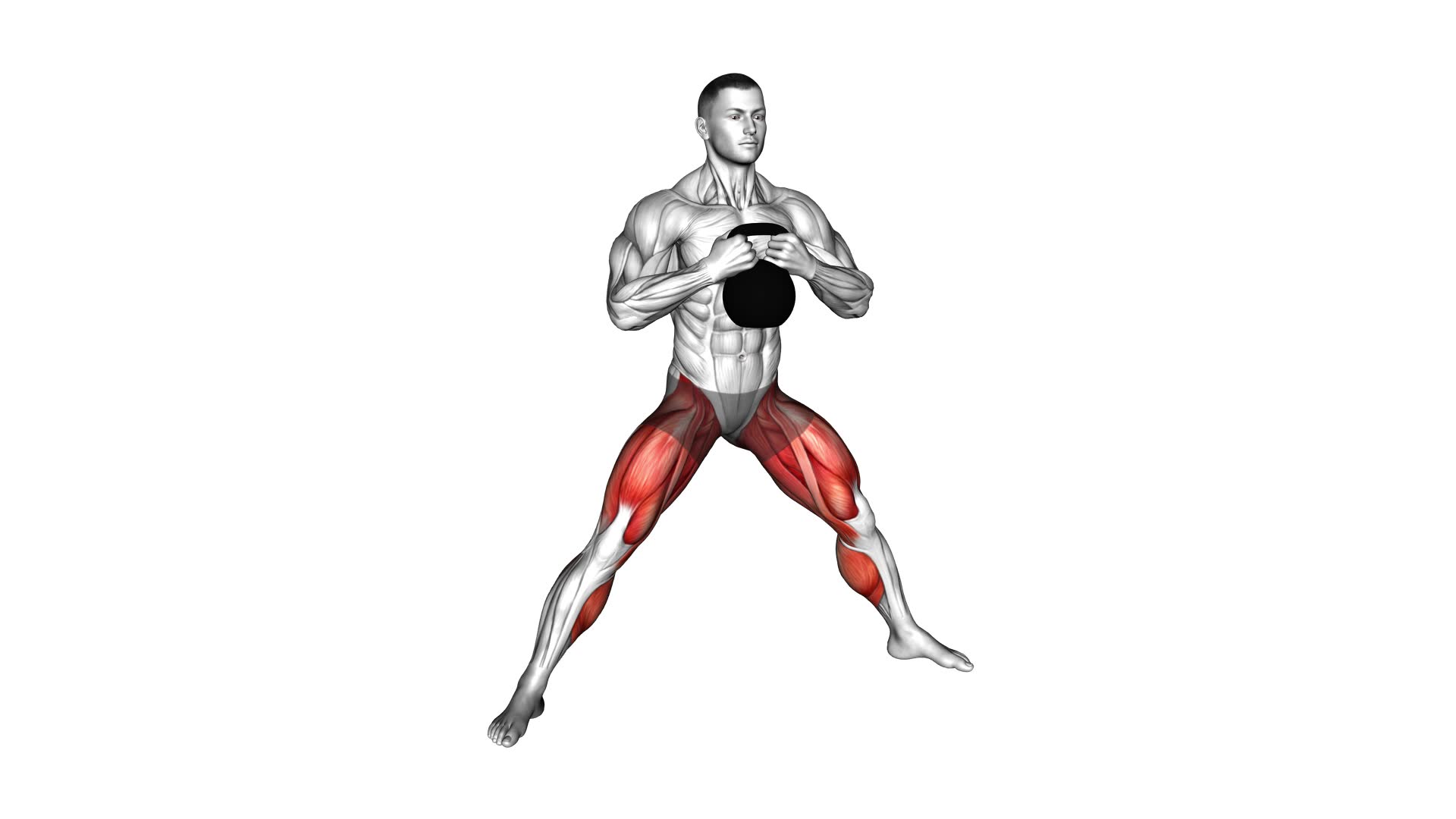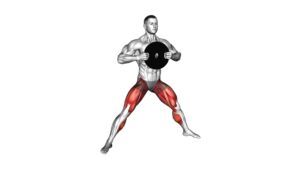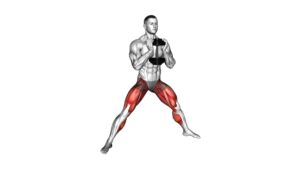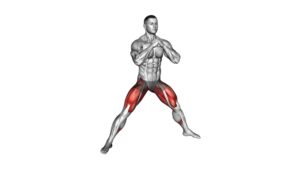Kettlebell Cossack Squat (male) – Video Exercise Guide & Tips

Are you looking for an effective lower body exercise that targets multiple muscle groups? Look no further than the Kettlebell Cossack Squat.
Watch This Exercise Video
This video exercise guide and tips will show you the proper form and technique to maximize your workout.
Whether you're a beginner or an advanced fitness enthusiast, this exercise can be modified to suit your fitness level.
Get ready to challenge yourself and see results with the Kettlebell Cossack Squat.
Key Takeaways
- The Kettlebell Cossack Squat improves mobility and increases range of motion in the hips.
- It strengthens lower body muscles including the quadriceps, hamstrings, glutes, and calves.
- The exercise challenges balance and stability, engaging core muscles.
- It enhances flexibility, functional movement, and helps build stronger and more toned legs and hips.
Benefits of the Kettlebell Cossack Squat
Improve your mobility and strengthen your lower body by incorporating the Kettlebell Cossack Squat into your workout routine. This exercise offers a multitude of benefits that can enhance your overall fitness level.
One of the primary advantages of the Kettlebell Cossack Squat is its ability to improve mobility. By performing this exercise, you're actively engaging your hip muscles, which helps to increase your range of motion. As a result, you'll experience improved flexibility and better functional movement.
Additionally, the Kettlebell Cossack Squat is highly effective in strengthening your lower body. This exercise targets your quadriceps, hamstrings, glutes, and calves, providing a comprehensive lower body workout. By incorporating this exercise into your routine, you can expect to develop stronger, more toned muscles in your legs and hips.
Furthermore, the Kettlebell Cossack Squat is a great way to challenge your balance and stability, as it requires you to maintain proper form throughout the movement. This exercise also engages your core muscles, providing an added bonus of strengthening your abdominal muscles.
So, if you're looking to improve your mobility and strengthen your lower body, the Kettlebell Cossack Squat is an excellent exercise to incorporate into your workout routine.
Now that you understand the benefits of the Kettlebell Cossack Squat, let's dive into the proper form and technique for this exercise.
Proper Form and Technique for the Exercise
To perform the Kettlebell Cossack Squat with proper form and technique, start by positioning yourself in a wide stance with your toes pointed slightly outward. This exercise requires a kettlebell, which should be held with both hands in front of your chest. As you begin the movement, shift your weight to one side while bending the knee of that leg, allowing the other leg to straighten out. Keep your back straight and your chest lifted throughout the exercise.
As you descend into the squat, make sure your knee tracks in line with your toes and doesn't collapse inward. The goal is to lower yourself as far as possible while maintaining control and stability.
Common mistakes to avoid include rounding the back, allowing the knee to collapse inward, and not fully engaging the glutes and core. It's important to maintain proper alignment and control throughout the exercise to prevent injury and maximize the benefits.
There are variations and modifications that can be made to suit different fitness levels and goals. Beginners can start with bodyweight only and gradually add weight as they become more comfortable with the movement. For those with limited mobility or flexibility, the squat can be performed with a support such as a TRX strap or a wall for assistance.
Advanced variations include adding a kettlebell swing or a jump at the top of the movement to increase intensity. Always listen to your body and choose the variation that feels challenging but manageable for you.
Tips for Getting the Most Out of Your Workout
To maximize your workout results, focus on incorporating proper form and technique while performing the Kettlebell Cossack Squat. By paying attention to these details, you can increase the effectiveness of your workout and maximize your results.
Firstly, it's important to maintain good posture throughout the exercise. Keep your chest lifted, shoulders back, and core engaged. This won't only help you target the correct muscles but also prevent any unnecessary strain or injury.
Secondly, make sure to use an appropriate weight for your fitness level. Using a kettlebell that's too heavy can compromise your form and increase the risk of injury. Start with a lighter weight and gradually increase as you become more comfortable and confident with the movement.
Additionally, focus on controlling the movement and performing each rep with intention. Avoid rushing through the exercise and instead, concentrate on engaging the muscles and maintaining proper alignment.
Lastly, incorporate the Kettlebell Cossack Squat into a well-rounded workout routine. Combine it with other exercises that target different muscle groups for a comprehensive workout. This will help maximize your overall workout efficiency and ensure that you're getting the most out of your training session.
Common Mistakes to Avoid While Performing the Squat
When performing the squat, it's essential to be aware of common mistakes to avoid. Proper technique is crucial for maximizing the benefits of this exercise and preventing injury.
One common mistake is allowing the knees to collapse inward during the squat. This places excessive stress on the knees and can lead to discomfort or even injury. To avoid this, focus on keeping your knees in line with your toes throughout the movement.
Another mistake isn't maintaining a neutral spine. It's important to engage your core and keep your back straight throughout the squat. This helps to protect your lower back and maintain proper form.
Additionally, not going low enough in the squat is a common error. To get the most out of this exercise, aim to lower your hips until your thighs are parallel to the ground. This ensures that you're engaging all the necessary muscles and achieving the full range of motion.
By avoiding these common mistakes and focusing on proper technique, you can perform the squat effectively and safely.
Now that you understand the common mistakes to avoid, let's move on to the next section, which will cover variations and modifications for different fitness levels.
Variations and Modifications for Different Fitness Levels
Now, let's explore how you can modify and adapt the kettlebell cossack squat to suit different fitness levels.
Whether you're a beginner or an advanced athlete, there are various ways to progress or modify this exercise to challenge yourself or cater to any limitations you may have.
For beginners or individuals with limited mobility, you can start by performing the cossack squat without any weights or kettlebells. This will allow you to focus on your form, balance, and range of motion. As you become more comfortable, you can gradually introduce a kettlebell or dumbbell to add resistance.
For those looking for more advanced variations, you can increase the weight of the kettlebell or perform the squat on an unstable surface such as a BOSU ball or balance board. This will engage more muscles and improve your stability and coordination.
In terms of injury prevention techniques, it's crucial to listen to your body and not push yourself beyond your limits. Always warm up before performing the exercise and ensure proper form and technique. If you have any pre-existing injuries or conditions, consult with a fitness professional or physical therapist for modifications or alternative exercises that are suitable for you.
Frequently Asked Questions
How Many Calories Can I Burn by Doing the Kettlebell Cossack Squat?
You can burn a significant amount of calories by incorporating the kettlebell cossack squat into your workout routine. This exercise engages multiple muscle groups, promoting strength, stability, and flexibility.
To perform it properly for maximum results, start by standing with your feet wider than shoulder-width apart, holding a kettlebell in front of your chest. Lower your body into a deep squat on one side, while keeping the other leg straight. Repeat on the other side.
Can the Kettlebell Cossack Squat Help Improve My Flexibility?
The Kettlebell Cossack Squat is a fantastic exercise for improving your flexibility and increasing mobility. By incorporating this exercise into your routine, you can reap the benefits of unilateral training, which helps to strengthen and stabilize your muscles.
The Kettlebell Cossack Squat specifically targets the muscles in your hips, glutes, and thighs, allowing for greater range of motion and flexibility.
With the help of the Video Exercise Guide & Tips {619312}, you can ensure proper form and maximize the effectiveness of this exercise.
Is It Necessary to Use a Kettlebell for the Cossack Squat, or Can I Use Other Types of Weights?
Using other types of weights for the Cossack squat is possible, but the kettlebell offers unique benefits. It helps to improve stability, core strength, and grip strength, which are crucial for performing the exercise effectively.
The off-centered weight distribution of a kettlebell also adds an extra challenge to the squat, engaging more muscles and enhancing overall strength development.
While you can use other weights, incorporating a kettlebell specifically designed for this exercise can maximize its benefits.
Can the Kettlebell Cossack Squat Help Strengthen My Core Muscles?
The kettlebell cossack squat is a great exercise for strengthening your core muscles. It targets your abs, obliques, and lower back, helping to improve stability and overall strength.
This exercise also offers several benefits, such as increasing flexibility in your hips and legs, improving balance, and enhancing your lower body strength.
Additionally, there are variations of cossack squats that you can try to further challenge your core and leg muscles.
How Long Should I Rest Between Sets When Performing the Kettlebell Cossack Squat?
When performing the kettlebell cossack squat, it's important to consider the rest duration between sets. Resting between sets allows your muscles to recover and replenish energy stores, ensuring proper muscle activation during each set.
The ideal rest duration for the kettlebell cossack squat can vary depending on your fitness level and goals. It's generally recommended to rest for about 60-90 seconds between sets to allow for adequate recovery while still maintaining muscle activation and intensity.
Conclusion
In conclusion, the Kettlebell Cossack Squat is a highly effective exercise for improving lower body strength, flexibility, and balance. By following the proper form and technique, you can maximize the benefits of this exercise.
Remember to start with lighter weights and gradually increase as your fitness level improves. Avoid common mistakes such as rounding the back or letting the knees collapse inward.
Lastly, don't be afraid to modify the exercise to suit your fitness level and goals.

Author
Years ago, the spark of my life’s passion ignited in my mind the moment I stepped into the local gym for the first time. The inaugural bead of perspiration, the initial endeavor, the very first surge of endorphins, and a sense of pride that washed over me post-workout marked the beginning of my deep-seated interest in strength sports, fitness, and sports nutrition. This very curiosity blossomed rapidly into a profound fascination, propelling me to earn a Master’s degree in Physical Education from the Academy of Physical Education in Krakow, followed by a Sports Manager diploma from the Jagiellonian University. My journey of growth led me to gain more specialized qualifications, such as being a certified personal trainer with a focus on sports dietetics, a lifeguard, and an instructor for wellness and corrective gymnastics. Theoretical knowledge paired seamlessly with practical experience, reinforcing my belief that the transformation of individuals under my guidance was also a reflection of my personal growth. This belief holds true even today. Each day, I strive to push the boundaries and explore new realms. These realms gently elevate me to greater heights. The unique combination of passion for my field and the continuous quest for growth fuels my drive to break new ground.







